1.6 The Perceptron Model
Your first model with weights

Recap: MP Neuron
What did we see in the previous chapter?
(c) One Fourth Labs

| Screen size (>5 in) | 1 | 0 | 1 | 1 | 1 | 0 | 1 | 0 | 1 | 0 |
| Battery (>2000mAh) | 0 | 0 | 0 | 1 | 0 | 1 | 1 | 1 | 1 | 0 |
| Like | 1 | 0 | 1 | 0 | 1 | 1 | 0 | 1 | 0 | 0 |










Boolean inputs
Boolean output
Linear
Fixed Slope
Few possible intercepts (b's)
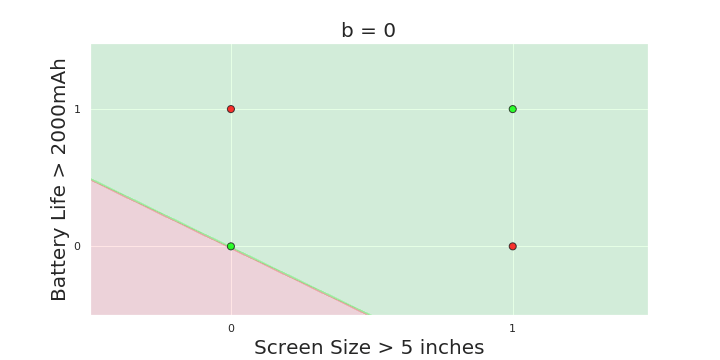
The Road Ahead
What's going to change now ?
(c) One Fourth Labs

\( \{0, 1\} \)
Classification








Loss
Model
Data
Task
Evaluation
Learning
Linear
Only one parameter, b
Real inputs
Boolean output
Brute force
Boolean inputs
Our 1st learning algorithm
Weights for every input
Data and Task
What kind of data and tasks can Perceptron process ?
(c) One Fourth Labs

Real inputs
| Launch (within 6 months) | 0 | 1 | 1 | 0 | 0 | 1 | 0 | 1 | 1 |
| Weight (g) | 151 | 180 | 160 | 205 | 162 | 182 | 138 | 185 | 170 |
| Screen size (inches) | 5.8 | 6.18 | 5.84 | 6.2 | 5.9 | 6.26 | 4.7 | 6.41 | 5.5 |
| dual sim | 1 | 1 | 0 | 0 | 0 | 1 | 0 | 1 | 0 |
| Internal memory (>= 64 GB, 4GB RAM) | 1 | 1 | 1 | 1 | 1 | 1 | 1 | 1 | 1 |
| NFC | 0 | 1 | 1 | 0 | 1 | 0 | 1 | 1 | 1 |
| Radio | 1 | 0 | 0 | 1 | 1 | 1 | 0 | 0 | 0 |
| Battery(mAh) | 3060 | 3500 | 3060 | 5000 | 3000 | 4000 | 1960 | 3700 | 3260 |
| Price (INR) | 15k | 32k | 25k | 18k | 14k | 12k | 35k | 42k | 44k |
| Like (y) | 1 | 0 | 1 | 0 | 1 | 1 | 0 | 1 | 0 |









| Launch (within 6 months) | 0 | 1 | 1 | 0 | 0 | 1 | 0 | 1 | 1 |
| Weight (<160g) | 1 | 0 | 1 | 0 | 0 | 0 | 1 | 0 | 0 |
| Screen size (<5.9 in) | 1 | 0 | 1 | 0 | 1 | 0 | 1 | 0 | 1 |
| dual sim | 1 | 1 | 0 | 0 | 0 | 1 | 0 | 1 | 0 |
| Internal memory (>= 64 GB, 4GB RAM) | 1 | 1 | 1 | 1 | 1 | 1 | 1 | 1 | 1 |
| NFC | 0 | 1 | 1 | 0 | 1 | 0 | 1 | 1 | 1 |
| Radio | 1 | 0 | 0 | 1 | 1 | 1 | 0 | 0 | 0 |
| Battery(>3500mAh) | 0 | 0 | 0 | 1 | 0 | 1 | 0 | 1 | 0 |
| Price > 20k | 0 | 1 | 1 | 0 | 0 | 0 | 1 | 1 | 1 |
| Like (y) | 1 | 0 | 1 | 0 | 1 | 1 | 0 | 1 | 0 |
(c) One Fourth Labs

| Launch (within 6 months) | 0 | 1 | 1 | 0 | 0 | 1 | 0 | 1 | 1 |
| Weight (g) | 151 | 180 | 160 | 205 | 162 | 182 | 138 | 185 | 170 |
| Screen size (inches) | 5.8 | 6.18 | 5.84 | 6.2 | 5.9 | 6.26 | 4.7 | 6.41 | 5.5 |
| dual sim | 1 | 1 | 0 | 0 | 0 | 1 | 0 | 1 | 0 |
| Internal memory (>= 64 GB, 4GB RAM) | 1 | 1 | 1 | 1 | 1 | 1 | 1 | 1 | 1 |
| NFC | 0 | 1 | 1 | 0 | 1 | 0 | 1 | 1 | 1 |
| Radio | 1 | 0 | 0 | 1 | 1 | 1 | 0 | 0 | 0 |
| Battery(mAh) | 3060 | 3500 | 3060 | 5000 | 3000 | 4000 | 1960 | 3700 | 3260 |
| Price (INR) | 15k | 32k | 25k | 18k | 14k | 12k | 35k | 42k | 44k |
| Like (y) | 1 | 0 | 1 | 0 | 1 | 1 | 0 | 1 | 0 |









| screen size |
|---|
| 5.8 |
| 6.18 |
| 5.84 |
| 6.2 |
| 5.9 |
| 6.26 |
| 4.7 |
| 6.41 |
| 5.5 |
| screen size |
|---|
| 0.64 |
| 0.87 |
| 0.67 |
| 0.88 |
| 0.7 |
| 0.91 |
| 0 |
| 1 |
| 0.47 |
min
max
Standardization formula
| Launch (within 6 months) | 0 | 1 | 1 | 0 | 0 | 1 | 0 | 1 | 1 |
| Weight (g) | 151 | 180 | 160 | 205 | 162 | 182 | 138 | 185 | 170 |
| Screen size | 0.64 | 0.87 | 0.67 | 0.88 | 0.7 | 0.91 | 0 | 1 | 0.47 |
| dual sim | 1 | 1 | 0 | 0 | 0 | 1 | 0 | 1 | 0 |
| Internal memory (>= 64 GB, 4GB RAM) | 1 | 1 | 1 | 1 | 1 | 1 | 1 | 1 | 1 |
| NFC | 0 | 1 | 1 | 0 | 1 | 0 | 1 | 1 | 1 |
| Radio | 1 | 0 | 0 | 1 | 1 | 1 | 0 | 0 | 0 |
| Battery(mAh) | 3060 | 3500 | 3060 | 5000 | 3000 | 4000 | 1960 | 3700 | 3260 |
| Price (INR) | 15k | 32k | 25k | 18k | 14k | 12k | 35k | 42k | 44k |
| Like (y) | 1 | 0 | 1 | 0 | 1 | 1 | 0 | 1 | 0 |
| battery |
|---|
| 3060 |
| 3500 |
| 3060 |
| 5000 |
| 3000 |
| 4000 |
| 1960 |
| 3700 |
| 3260 |
| battery |
|---|
| 0.36 |
| 0.51 |
| 0.36 |
| 1 |
| 0.34 |
| 0.67 |
| 0 |
| 0.57 |
| 0.43 |
min
max
Data Preparation
Can the data be used as it is ?
| Launch (within 6 months) | 0 | 1 | 1 | 0 | 0 | 1 | 0 | 1 | 1 |
| Weight (g) | 151 | 180 | 160 | 205 | 162 | 182 | 138 | 185 | 170 |
| Screen size | 0.64 | 0.87 | 0.67 | 0.88 | 0.7 | 0.91 | 0 | 1 | 0.47 |
| dual sim | 1 | 1 | 0 | 0 | 0 | 1 | 0 | 1 | 0 |
| Internal memory (>= 64 GB, 4GB RAM) | 1 | 1 | 1 | 1 | 1 | 1 | 1 | 1 | 1 |
| NFC | 0 | 1 | 1 | 0 | 1 | 0 | 1 | 1 | 1 |
| Radio | 1 | 0 | 0 | 1 | 1 | 1 | 0 | 0 | 0 |
| Battery | 0.36 | 0.51 | 0.36 | 1 | 0.34 | 0.67 | 0 | 0.57 | 0.43 |
| Price (INR) | 15k | 32k | 25k | 18k | 14k | 12k | 35k | 42k | 44k |
| Like (y) | 1 | 0 | 1 | 0 | 1 | 1 | 0 | 1 | 0 |
Data Preparation
Can the data be used as it is ?
(c) One Fourth Labs

| Launch (within 6 months) | 0 | 1 | 1 | 0 | 0 | 1 | 0 | 1 | 1 |
| Weight | 0.19 | 0.63 | 0.33 | 1 | 0.36 | 0.66 | 0 | 0.70 | 0.48 |
| Screen size | 0.64 | 0.87 | 0.67 | 0.88 | 0.7 | 0.91 | 0 | 1 | 0.47 |
| dual sim | 1 | 1 | 0 | 0 | 0 | 1 | 0 | 1 | 0 |
| Internal memory (>= 64 GB, 4GB RAM) | 1 | 1 | 1 | 1 | 1 | 1 | 1 | 1 | 1 |
| NFC | 0 | 1 | 1 | 0 | 1 | 0 | 1 | 1 | 1 |
| Radio | 1 | 0 | 0 | 1 | 1 | 1 | 0 | 0 | 0 |
| Battery | 0.36 | 0.51 | 0.36 | 1 | 0.34 | 0.67 | 0 | 0.57 | 0.43 |
| Price | 0.09 | 0.63 | 0.41 | 0.19 | 0.06 | 0 | 0.72 | 0.94 | 1 |
| Like (y) | 1 | 0 | 1 | 0 | 1 | 1 | 0 | 1 | 0 |









The Model
What is the mathematical model ?
(c) One Fourth Labs

| Launch (within 6 months) | 0 | 1 | 1 | 0 | 0 | 1 | 0 | 1 | 1 |
| Weight | 0.19 | 0.63 | 0.33 | 1 | 0.36 | 0.66 | 0 | 0.70 | 0.48 |
| Screen size | 0.64 | 0.87 | 0.67 | 0.88 | 0.7 | 0.91 | 0 | 1 | 0.47 |
| dual sim | 1 | 1 | 0 | 0 | 0 | 1 | 0 | 1 | 0 |
| Internal memory (>= 64 GB, 4GB RAM) | 1 | 1 | 1 | 1 | 1 | 1 | 1 | 1 | 1 |
| NFC | 0 | 1 | 1 | 0 | 1 | 0 | 1 | 1 | 1 |
| Radio | 1 | 0 | 0 | 1 | 1 | 1 | 0 | 0 | 0 |
| Battery | 0.36 | 0.51 | 0.36 | 1 | 0.34 | 0.67 | 0 | 0.57 | 0.43 |
| Price | 0.09 | 0.63 | 0.41 | 0.19 | 0.06 | 0 | 0.72 | 0.94 | 1 |
| Like (y) | 1 | 0 | 1 | 0 | 1 | 1 | 0 | 1 | 0 |









\(x_1\)
b
\(x_n\)
\(\hat{y}\)
\(x_2\)
\(w_1\)
\(w_2\)
\(w_n\)
The Model
How is this different from the MP Neuron Model ?
(c) One Fourth Labs

Real inputs
Linear
Weights for each input
Adjustable threshold
Boolean inputs
Linear
Inputs are not weighted
Adjustable threshold


MP Neuron
Perceptron
The Model
What do weights allow us to do ?
(c) One Fourth Labs










| Launch (within 6 months) | 0 | 1 | 1 | 0 | 0 | 1 | 0 | 1 | 1 |
| Weight (g) | 151 | 180 | 160 | 205 | 162 | 182 | 158 | 185 | 170 |
| Screen size (inches) | 5.8 | 6.18 | 5.84 | 6.2 | 5.9 | 6.26 | 5.7 | 6.41 | 5.5 |
| dual sim | 1 | 1 | 0 | 0 | 0 | 1 | 0 | 1 | 0 |
| Internal memory (>= 64 GB, 4GB RAM) | 1 | 1 | 1 | 1 | 1 | 1 | 1 | 1 | 1 |
| NFC | 0 | 1 | 1 | 0 | 1 | 0 | 1 | 1 | 1 |
| Radio | 1 | 0 | 0 | 1 | 1 | 1 | 0 | 0 | 0 |
| Battery(mAh) | 3060 | 3500 | 3060 | 5000 | 3000 | 4000 | 2960 | 3700 | 3260 |
| Price (INR) | 15k | 32k | 25k | 18k | 14k | 12k | 35k | 42k | 44k |
| Like (y) | 1 | 0 | 1 | 0 | 1 | 1 | 0 | 1 | 0 |
\(x_1\)
b
\(x_n\)
\(\hat{y}\)
\(x_2\)
\(w_1\)
\(w_2\)
\(w_n\)
\(w_{price} \rightarrow -ve\)
Like \(\alpha \frac{1}{price}\)
Some Math fundae
Can we write the perceptron model slightly more compactly?
(c) One Fourth Labs

x : [0, 0.19, 0.64, 1, 1, 0]
w: [0.3, 0.4, -0.3, 0.1, 0.5]
\(\textbf{x} \in R^5\)
\(\textbf{w} \in R^5\)
\( \vec{x} \)
\( \vec{w} \)
\(\textbf{x}.\textbf{w}\) = ?
\(\textbf{x}.\textbf{w} = x_1.w_1 + x_2.w_2 + ... x_n.w_n\)
\(x_1\)
b
\(x_n\)
\(\hat{y}\)
\(x_2\)
\(w_1\)
\(w_2\)
\(w_n\)
\( \textbf{x} \)
\( \textbf{w} \)
\(\textbf{x}.\textbf{w} \)
The Model
What is the geometric interpretation of the model ?
(c) One Fourth Labs

More freedom
MP neuron
Perceptron
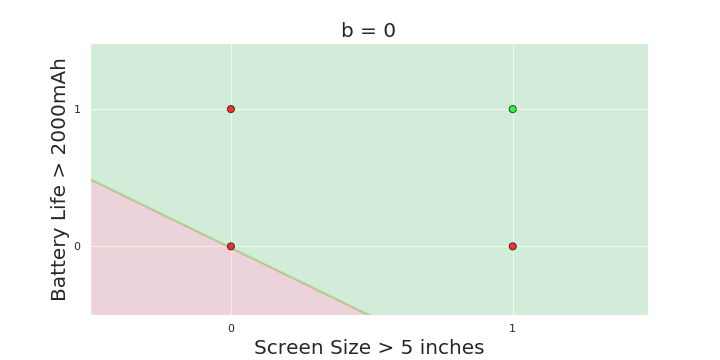
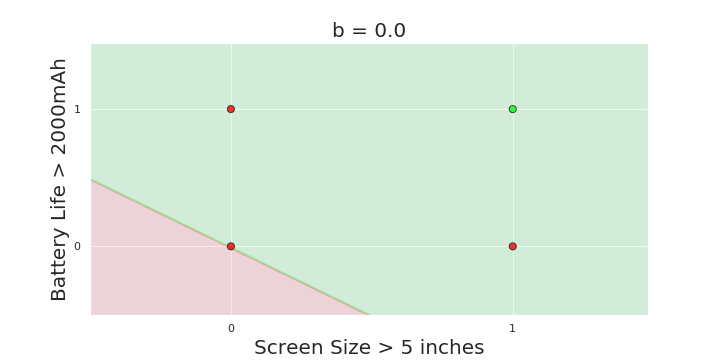
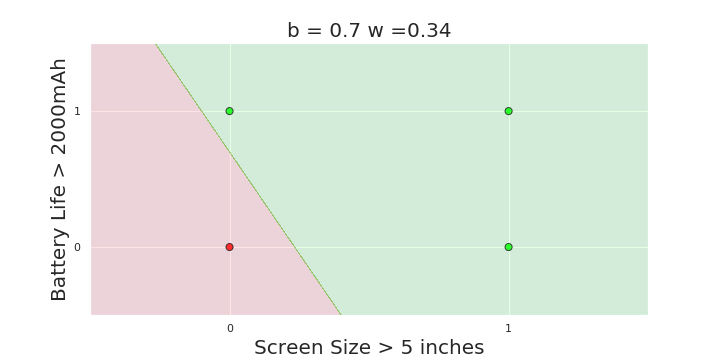
The Model
Why is more freedom important ?
(c) One Fourth Labs

More freedom
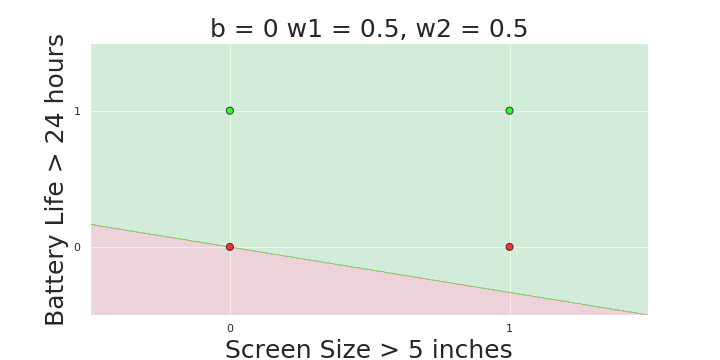
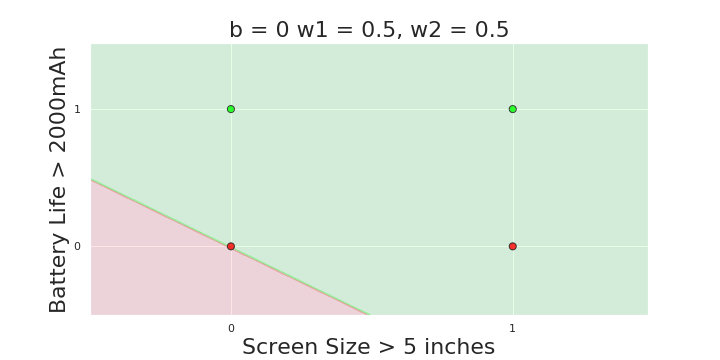
MP neuron
Perceptron
The Model
Is this all the freedom that we need ?
(c) One Fourth Labs

We want even more freedom


The Model
What if we have more than 2 dimensions ?
(c) One Fourth Labs


Loss Function
What is the loss function that you use for this model ?
(c) One Fourth Labs

| Weight | Screen size | Like |
|---|---|---|
| 0.19 | 0.64 | 1 |
| 0.63 | 0.87 | 1 |
| 0.33 | 0.67 | 0 |
| 1 | 0.88 | 0 |
| Weight | Screen size | Like | Loss | |
|---|---|---|---|---|
| 0.19 | 0.64 | 1 | 1 | 0 |
| 0.63 | 0.87 | 1 | 0 | 1 |
| 0.33 | 0.67 | 0 | 1 | 1 |
| 1 | 0.88 | 0 | 0 | 0 |
Q. What is the purpose of the loss function ?
A. To tell the model that some correction needs to be done!
Q. How ?
A. We will see soon
Loss Function
How is this different from the squared error loss function ?
(c) One Fourth Labs

Squared error loss is equivalent to perceptron loss when the outputs are boolean.
| Weight | Screen size | Like | |
|---|---|---|---|
| 0.19 | 0.64 | 1 | 1 |
| 0.63 | 0.87 | 1 | 0 |
| 0.33 | 0.67 | 0 | 1 |
| 1 | 0.88 | 0 | 0 |
| Perceptron Loss | Squared Error Loss |
|---|---|
0
0
0
0
1
1
1
1
Perceptron loss =
Squared Error loss =
Loss Function
Can we plot the loss function ?
(c) One Fourth Labs

|
Price |
Like |
|---|---|
| 0.2 | 1 |
| 0.4 | 1 |
| 0.6 | 0 |
| 0.7 | 0 |
| 0.45 | 1 |
| Price | Like | (w=0.5,b=0.3) | Loss |
|---|---|---|---|
| 0.2 | 1 | 1 | 0 |
| 0.4 | 1 | 1 | 0 |
| 0.6 | 0 | 1 | 1 |
| 0.7 | 0 | 0 | 0 |
| 0.45 | 1 | 1 | 0 |
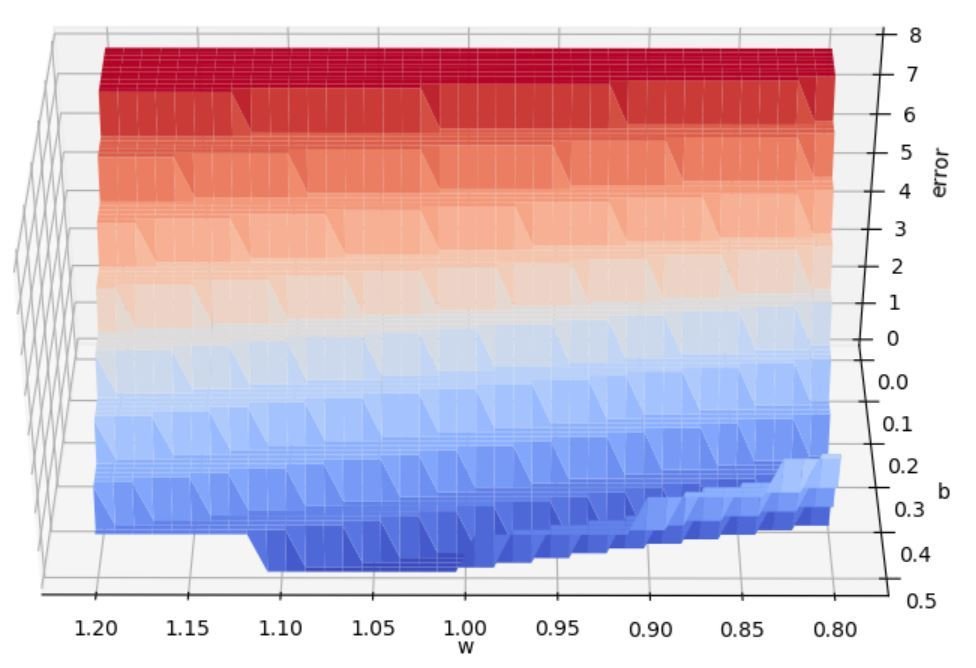
| Price | Like | (w=0.8,b=0.1) | Loss |
|---|---|---|---|
| 0.2 | 1 | 0 | 1 |
| 0.4 | 1 | 0 | 1 |
| 0.6 | 0 | 0 | 0 |
| 0.7 | 0 | 0 | 0 |
| 0.45 | 1 | 0 | 1 |
| Price | Like | (w=1,b=0.5) | Loss |
|---|---|---|---|
| 0.2 | 1 | 1 | 0 |
| 0.4 | 1 | 1 | 0 |
| 0.6 | 0 | 0 | 0 |
| 0.7 | 0 | 0 | 0 |
| 0.45 | 1 | 1 | 0 |
Error = 1
Error = 3
Error = 0
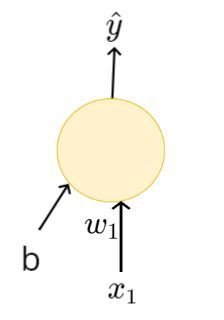
Learning Algorithm
What is the typical recipe for learning parameters of a model ?
(c) One Fourth Labs

Initialise
\(w_1, w_2, b \)
Iterate over data:
\( \mathscr{L} = compute\_loss(x_i) \)
\( update(w_1, w_2, b, \mathscr{L}) \)
till satisfied
\(\mathbf{w} = [w_1, w_2] \)
| Weight | Screen size | Like |
|---|---|---|
| 0.19 | 0.64 | 1 |
| 0.63 | 0.87 | 1 |
| 0.33 | 0.67 | 0 |
| 1 | 0.88 | 0 |
Learning Algorithm
What does the perceptron learning algorithm look like ?

Initialize w randomly
while !convergence do
Pick random x ∈ P U N
if y_i == 1 and w.x < b then
w = w + x
b = b + 1
end
if y_i == 0 and w.x ≥ b then
w = w − x
b = b - 1
end
end
/*the algorithm converges when all the
inputs are classified correctly */X is also a vector!
Learning Algorithm
Can we see this algorithm in action ?
(c) One Fourth Labs

Initialize w randomly
while !convergence do
Pick random x ∈ P U N
if y_i == 1 and w.x < b then
w = w + x
b = b + 1
end
if y_i == 0 and w.x ≥ b then
w = w − x
b = b - 1
end
end
/*the algorithm converges when all the
inputs are classified correctly */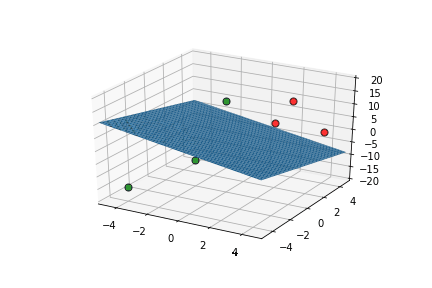
| x1 | x2 | x3 | |||
|---|---|---|---|---|---|
| 2 | 2 | 5 | 10 | 1 | 1 |
| 2 | 4 | 10 | 17 | 1 | 1 |
| 4 | 4 | 0 | 11 | 1 | 1 |
| 0 | 0 | 15 | 14 | 1 | 0 |
| -4 | -4 | -15 | -15 | 0 | 0 |
| -2 | 0 | -10 | -26 | 0 | 0 |
This triggers learning!
Learning Algorithm
What is the geometric interpretation of this ?

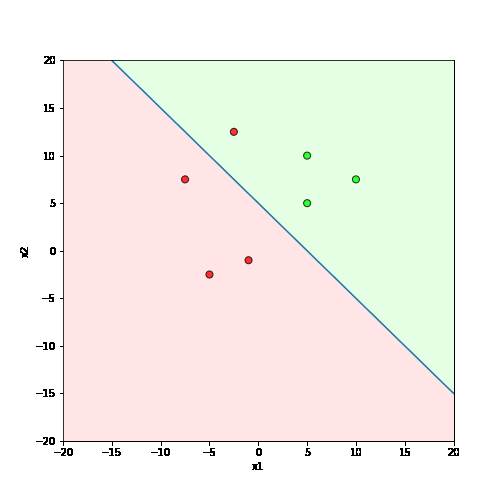
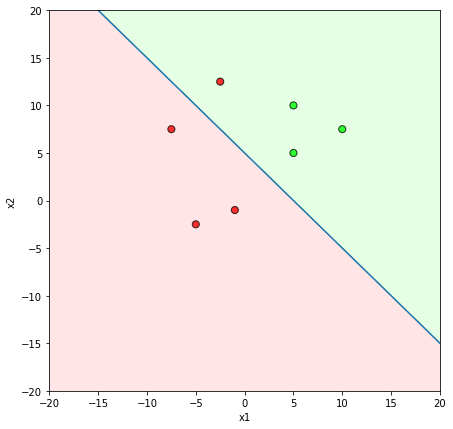
Misclassified
Let's learn!
Initialize w randomly
while !convergence do
Pick random x ∈ P U N
if y_i == 1 and w.x < b then
w = w + x
b = b + 1
end
if y_i == 0 and w.x ≥ b then
w = w − x
b = b - 1
end
end
/*the algorithm converges when all the
inputs are classified correctly */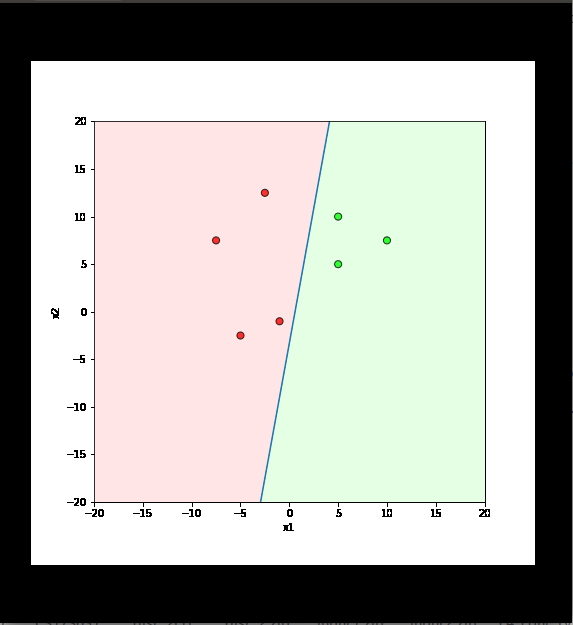
Learning Algorithm
Will this algorithm always work ?

Only if the data is linearly separable
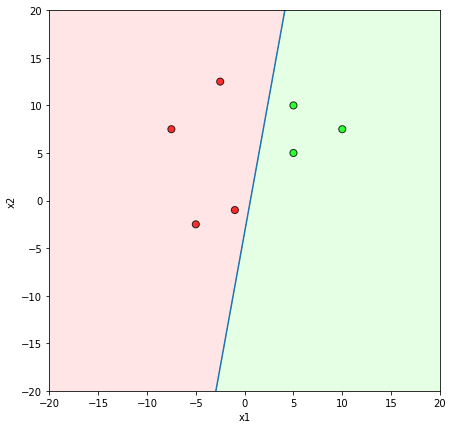
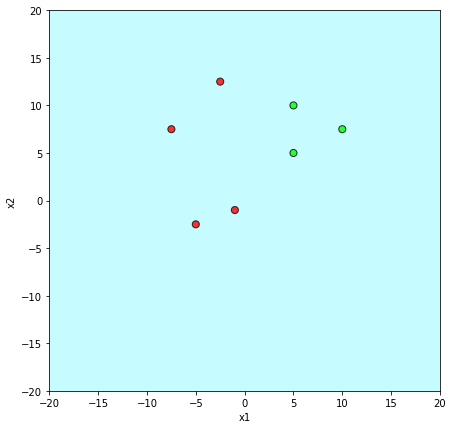
Learning Algorithm
Can we prove that it will always work for linearly separable data ?
(c) One Fourth Labs


Learning Algorithm
What does "till satisfied" mean ?
(c) One Fourth Labs

Initialise
\(w_1, w_2, b \)
Iterate over data:
\( \mathscr{L} = compute\_loss(x_i) \)
\( update(w_1, w_2, b, \mathscr{L}) \)
till satisfied
\( total\_loss = 0 \)
\( total\_loss += \mathscr{L} \)
till total loss becomes 0
till total loss becomes < \( \epsilon \)
till number of iterations exceeds k (say 100)
Evaluation
How do you check the performance of the perceptron model?
(c) One Fourth Labs

| Launch (within 6 months) | 0 | 1 | 1 | 0 | 0 | 1 | 0 | 1 | 1 | 0 |
| Weight (<160g) | 1 | 0 | 1 | 0 | 0 | 0 | 1 | 0 | 0 | 1 |
| Screen size (<5.9 in) | 1 | 0 | 1 | 0 | 1 | 0 | 1 | 0 | 1 | 0 |
| dual sim | 1 | 1 | 0 | 0 | 0 | 1 | 0 | 1 | 0 | 0 |
| Internal memory (>= 64 GB, 4GB RAM) | 1 | 1 | 1 | 1 | 1 | 1 | 1 | 1 | 1 | 0 |
| NFC | 0 | 1 | 1 | 0 | 1 | 0 | 1 | 1 | 1 | 0 |
| Radio | 1 | 0 | 0 | 1 | 1 | 1 | 0 | 0 | 0 | 0 |
| Battery(>3500mAh) | 0 | 0 | 0 | 1 | 0 | 1 | 0 | 1 | 0 | 0 |
| Price > 20k | 0 | 1 | 1 | 0 | 0 | 0 | 1 | 1 | 1 | 0 |
| Like? (y) | 1 | 0 | 1 | 0 | 1 | 1 | 0 | 1 | 0 | 0 |
| predicted | 1 | 0 | 0 | 1 | 1 | 1 | 1 | 0 | 0 | 0 |

| 1 | 0 | 0 | 1 |
| 0 | 1 | 1 | 1 |
| 0 | 1 | 1 | 1 |
| 0 | 1 | 0 | 0 |
| 1 | 0 | 0 | 0 |
| 0 | 0 | 1 | 0 |
| 1 | 1 | 1 | 0 |
| 1 | 1 | 1 | 0 |
| 0 | 0 | 1 | 0 |
| 0 | 1 | 0 | 0 |
| 0 | 1 | 1 | 0 |
Training data
Test data
Take-aways
So when will you use perceptron?
(c) One Fourth Labs

\( \in \mathbb{R} \)
Classification







Loss
Model
Data
Task
Evaluation
Learning
Real inputs
Boolean Output
Perceptron Learning Algorithm
An Eye on the Capstone project
How is perceptron related to the capstone project ?
(c) One Fourth Labs

Boolean
text/
no-text
Perceptron Learning
Algorithm
The simplest model for binary classification

Data

Task






Model

Loss

Learning

Evaluation

-8.5 -1.7 ... 9.0
-0.4 6.7 ... 4.7

...
| 1 | 0 | 0 | 1 |
| 0 | 1 | 1 | 1 |

Squared
error loss
Assignments
How do you view the learning process ?
(c) One Fourth Labs

Assignment: Give some data including negative values and ask them to standardize it
Copy of Copy for Preksha's 1.6 Perceptron
By ananya_s_b
Copy of Copy for Preksha's 1.6 Perceptron
- 636

